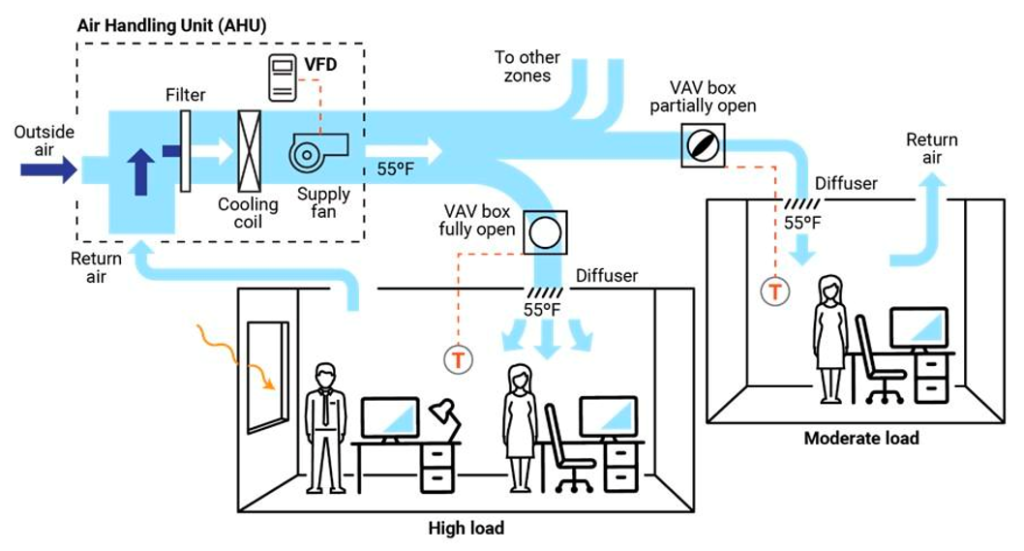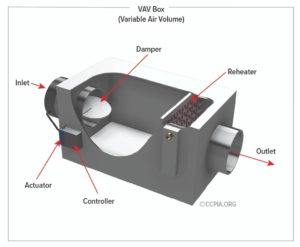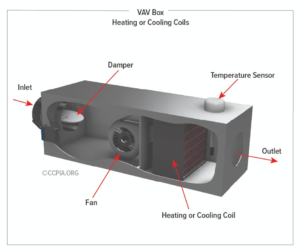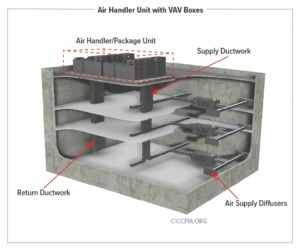There are two types of air-handling systems: constant volume (CV), and variable air volume (VAV). In a CV system, a constant amount of air flows through the system whenever it is on. A VAV system changes the amount of airflow in response to heating and cooling load changes. The latter allows commercial buildings to better regulate the interior temperature throughout different zones/spaces. A VAV system is typically found in mixed-use office buildings for improved energy efficiency and occupant comfort.
In VAV systems, the air volume of the main trunk system will remain constant, but the volume or flow rate through the supplied or branch air will vary. As a result, the VAV system allows different zones to operate at different temperatures from the same air-handling unit (AHU) and ventilation system.
The benefit of a VAV system is the ability to have a balanced condition in the building, or equalized temperatures across the entire building. An example is a solar gain on one side of the building, creating a considerably warmer area than another space that’s away from the sunny side of the building, as in the illustration below.

There are four different types of VAV systems:
- Single-duct VAV box: This is the most common type. It can be configured as cooling-only, or with reheating.
- Fan-assisted VAV box: This uses a fan to pull warmer plenum air/return air into the zone and displace required reheat energy.
- Dual-ducted VAV box: The main system has a separate duct for warm (or neutral) and cold air, and the flow is modulated to deliver air based on need.
- Induction VAV box: This uses the induction principle instead of a fan to pull warmer plenum air/return air into the zone and displace required reheat energy.


Components
The VAV terminal box is installed on the primary supply ductwork. A pressure sensor is also installed so that the static pressure in the supply duct can be monitored and controlled. This will control the fan speed and help with saving energy.
NOTE: The air-handling unit (AHU) includes the air filters, cooling coils, heating source, and supply fans.
Depending on the type of the VAV box, the following describes key components for this system:
- airflow sensor. It measures the flow of air and adjusts the damper position.
- damper. It opens and closes to modulate the airflow based on the airflow sensor and temperature needs.
- fan. This is for systems that need to supplement ducted airflow (series fans) or supplement/displace reheat needs (parallel fans).
- filter. This is for fan-powered boxes to filter the air from the plenum or other return-air sources.
- reheat coil. This is an electric or hydronic coil installed to warm the air leaving the box.
- system controls. These may be pneumatic, electronic, or direct digital. An airflow sensor in the box measures airflow. The box controller modulates the damper and heating control using the airflow and zone temperature inputs to satisfy the zone requirements.
- zone temperature control. This is the primary control point for any VAV system. Either a zone sensor or thermostat provides a signal to the VAV controller.
Operation
The central AHU, rooftop unit (RTU), or package unit provides airflow through a duct system. The airflow passes through a VAV box before being ducted into the desired zone/space. Within the box is one of the four types of VAV systems that opens or closes dampers, and, in some cases, modulates the airflow through mixing boxes powered by VAV fans. The airflow may be static and constant from the source or thermostatically controlled, and it fluctuates as loads in various zones of the building change. If the system is designed only to provide cool air, the temperature from the AHU will be constant, typically around 55º F.
A thermostat will activate the damper in the VAV box and control the airflow through it. The temperature will either be too hot, too cold, or just right. If the temperature is too cold, the damper might close. If the temperature is too hot, it might open wider. If the temperature is just right, it might close partially or remain in the same position.
Additionally, if the temperature is too cold, an electric reheat system may be installed in the VAV. This electric strip heat will activate and heat the air as it passes through the VAV, or it may be a heat exchanger with a radiator with hot water tubing instead. A central boiler system would provide this hot water in a central mechanical room. Both of these methods would provide warmer air to the desired zone being served by that particular VAV box.
The exception would be an AHU that distributes air volume solely through the ducts. A reheat element or heat exchanger is attached to hot- and cold-water sources at the VAV. The hot source may be a boiler, and the cold source may be a chiller system. The two-pipe system would be able to provide hot and cold water through two different heat exchangers. This type of system allows for the greatest opportunity to control any temperature variations.

Inspection

A VAV zone thermostat. The label indicates its RTU and its Zone 7.
Commercial property inspectors should operate VAV systems unless the system is shut down or in the off position.
Consider the following during an inspection:
- locate individual zones and thermostats;
- locate VAV boxes;
- activate thermostats to open or close VAV boxes and observe their operation; and
- adjust the thermostat to active the opposite mode (if present).
The International Standards of Practice for Inspecting Commercial Properties (ComSOP) does not require the inspector to move drop ceiling tiles, but the movement of the tiles might be the only way to expose the VAV system. If the tiles are not moved, the inspector can still assess the system using infrared thermometers and cameras at registers, grilles, and vents, in addition to operating the thermostats. In this case, the inspector cannot view the system but can identify whether the system is operating properly by recording the temperature. The inspector should note in the report the method of inspection.
Conclusion
VAV systems are a common method of providing comfort throughout an office space. These systems are part of a commercial inspection, so understanding how they function is key. Testing their operation using non-invasive methods will allow the inspector to inform the client about what type of system is installed, and whether it is functioning properly.
Article Written By: Rob Claus, CMI≤sup>®
Additional Resources for Commercial Property Inspectors:


